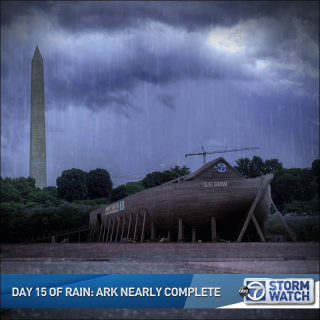Imagine my surprise to sit down at my computer this morning to check Facebook, and be greeted by this image from ABC affiliate WJLA:
First of all, yes, I’m as tired of the rain as anyone else. I’ve been working in rail yards quite a bit as of late, and due to tight clearances and high voltage in there, I’m not allowed to use an umbrella. So if I’m outside, I’m going to get wet. So I admit: this photo amused me a little bit.
However, does anyone else recognize that ark? That looks a lot like the ark from Evan Almighty – because it is. Recognize that angle, though? You should – it’s from this site. Here is your ark:
This is from a 2006 Journal entry where I delivered on a promise to show photos of said ark. The photo also appears in the Wikipedia article for Evan Almighty, because as a former contributor to Wikipedia, I used to upload material there to help build the encyclopedia, among other things.
It’s now been more than three years since I stopped contributing to Wikipedia. I left because the environment on Wikipedia was more toxic than the working environment at my then-employer, Food & Water Watch – and that says a lot. Not surprising that I left both within about seven months of each other. But in Wikipedia’s case, it seems to be the gift that keeps on giving, as I have to deal with old material that was uploaded years ago that pops up in downstream uses on a routine basis, and why I now sometimes wish that I had never posted photos to Wikipedia in the first place.
The problem is with the Wikimedia Foundation’s free-content model, i.e. Creative Commons licensing. In theory, this should work well. People are allowed to freely use these works in their own materials, so long as they comply with the terms of the license, which, at minimum, is attribution. In practice, however, people treat Creative Commons and similar licensing as de facto public domain, but there is a major difference between public domain and Creative Commons that is lost on most people. Public domain, when it applies to works that would otherwise clearly not be out of copyright (the normal term of copyright’s being the life of the author plus 70 years), represents an explicit relinquishment of all intellectual property rights. That requires specific action to do, as the default is copyright, i.e. if it has been created in a fixed form, it is copyrighted. Yes, even your little back-of-the-napkin doodle is copyrighted (and if you drew it, it’s your copyright). Creative Commons is that way of saying, “Yes, I still hold the reins on my works, but I will allow you to use it, provided that you do X, Y, and Z.” But too many people just see the “I will allow you to use it” part and run with it. I have found so many instances where people just throw a photo of mine up in something and run it, not providing any attribution. That’s outside the letter and spirit of the license. And too often, it comes from people who really should know better.
All of this is why I discontinued Creative Commons licensing on Schumin Web back in 2014. I got tired of going after people for a byline at most. Too much effort for not enough payoff, especially when most people have been either unable or unwilling to understand what a Creative Commons license means. After all, when people think that they can use something, they will, and so who am I, as the copyright holder, to tell them otherwise? So the hell with it – Creative Commons is gone. That has worked out well for me so far, as professional photo licensing has turned into a viable revenue stream, both on the front end through Pixels.com, as well as on the back end through Pixsy. And experience has shown that you will pay more if I have to go through Pixsy to get my money, vs. properly licensing stuff on the front end like you’re supposed to.
It also irritates me the way some people are just plain unwilling to pay photographers for their work. I recently had an instance with a large bank that wanted to feature one of my photos from the Roanoke portion of An Urban Comparison in a history gallery in one of their buildings. As soon as I mentioned that payment would be required for such a usage, referring them to the Pixels page for that photo, I never heard from them again. And for a company that made $22 billion in profit last year, they definitely could have afforded to spend $100 on a photo license.
In the case of WJLA, this infringement wasn’t worth the hassle of going after them for money or anything like that. So I simply filed a DMCA takedown notice with Facebook, as well as the Twitter, and had it blasted off of the Internet. Shame on them for engaging in this sort of nonsense in the first place. If my photo is going to get almost 10,000 shares, I want everyone to know that it’s mine. Large, for-profit media companies in particular should know better than to steal images without following licenses. And the thing is, if they would have asked up front like they were supposed to, I very well might have said yes, but now they’ll never know because they bypassed me entirely and did their own thing.
Bottom line in all of this? Don’t steal. Just because it’s on the Internet, and especially just because it’s on Wikipedia, does not mean that it’s open season.

